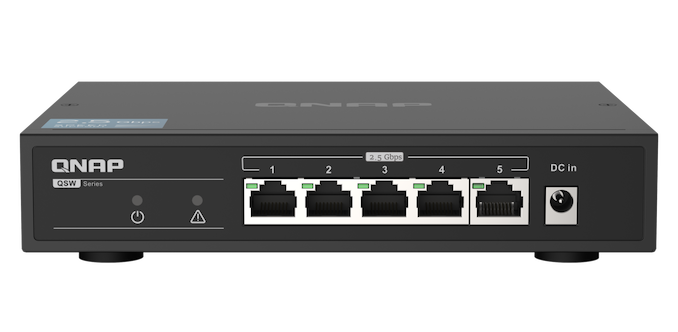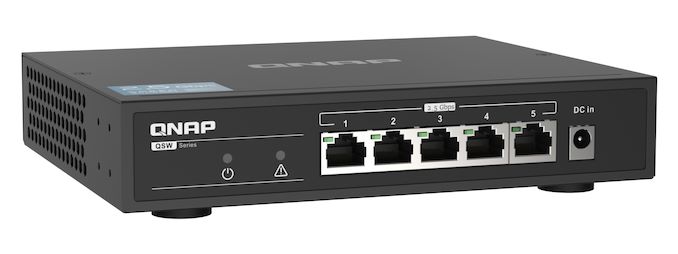At Last, a 2.5Gbps Consumer Network Switch: QNAP Releases QSW-1105-5T 5-Port Switch
by Ryan Smith on July 17, 2020 11:30 AM EST- Posted in
- Networking
- QNAP
- NBASE-T
- 2.5GBase-T
- Ethernet
- 2.5 GbE

After entirely too long of a delay, the wait for faster consumer-grade network switches appears to be coming to an end. This week QNAP launched its QSW-1105-5T switch, one of the industry’s first unmanaged 2.5Gbps (2.5GBASE-T) switches. The 5-port switch supports 2.5GbE operation on all five of its RJ45 Ethernet ports, and along with being unmanaged it is also fanless, allowing the switch to work maintenance-free and installed virtually anywhere. The QSW-1105-5T is already on sale in Taiwan for roughly $100, meaning that we’re looking at a price-per-port of about $20.
The saga of NBASE-T has been something of a long one. First introduced in 2016, the standard added the then-new 2.5GBASE-T and 5GBASE-T modes, which were designed to offer a series of intermediate steps between the existing 1Gbps (1000BASE-T) and 10Gbps (10GBASE-T) standards. By scaling down parts of the 10GBASE-T spec, the new standards would allow more modest – but still many times faster – network transmission rates than 1Gbps Ethernet, all the while being able to reuse existing Cat5e and Cat6 cabling. Overall, 2.5GBASE-T allows for 2.5Gbps Ethernet over Cat5e at the same 100m distances as 1Gbps Ethernet, while 5GBASE-T allows for 5Gbps speeds over 100m runs of Cat6, as well as quasi-official support for shorter Cat5e runs.
Given the technology reuse, moderately-priced NBASE-T network cards were quick to hit the market. However affordable switches have been a more complex matter: while the high initial price of NBASE-T was easy enough to eat on a single controller, multiplied over several ports on a switch, it quickly drove up the price tag. As a result, the market for NBASE-T switches has largely between split between downgraded pro gear like Netgear’s $70-per-port XS505M, and mixed-port switches like Asus’s XG-U2008, which offer just two 10G/NBASE-T ports along with a slew of Gigabit Ethernet ports. So cheap NBASE-T networking options have remained elusive, at least until now.
Thankfully, in the last year we’ve finally started seeing the slower of the NBASE-T modes, 2.5GBASE-T, sprint towards wide adoption. The 2.5Gbps standard is the cheapest to implement, and with recent controller releases from the likes of RealTek and Intel, 2.5Gbps controllers have quickly become a staple on high-end motherboards. Accordingly, with the price per port coming down for 2.5Gbps controllers, it’s also bringing down the price of whole switches. And this is where QNAP’s new switch comes in.
The QSW-1105-5T is one of the first switches to be released using these new generations of cheap controllers. Aimed squarely at the home and SMB markets, the switch doesn’t offer any frills such as network management, Power over Ethernet, or SFP+ ports. Instead it focuses on the things that matter for the home market: supporting 2.5Gbps networking in a small, passively-cooled switch that’s suitable to be neglected by being tucked under a desk or in a closet.
| QNAP QSW-1105-5T Switch | |
| Speeds | 100M/1G/2.5G |
| Ports (RJ45) | 5 |
| Managed | No |
| Power | 12 W |
| Dimensions | 3.4 x 18 x 14.5 cm |
| Cooling | Passive (Fanless) |
| Price | ~$100 |
As the first of what will undoubtedly be many 2.5G switches over the coming months, the QSW-1105-5T also gives us our first real look at what we can expect from this generation of switches as far as footprints and power consumption goes. Since it’s not carved from a pro-grade switch, the 18 cm x 14.5 cm switch is significantly smaller than earlier NBASE-T switches. And with a maximum power consumption rating of 12 W, we’re looking at power consumption of just a bit over 2 Watts per port, which is also a significant improvement over admittedly far more powerful switches.
All of which sounds unremarkable, and indeed that’s exactly what makes the QSW-1105-5T so interesting. The biggest barrier to wide consumer adoption over the last few years has been the cost – both in regards to the core technology and added frills – so we’ve been waiting for quite a while to see NBASE-T technology transition from pro-grade switches to cheap, consumer-grade gear.
Otherwise, QNAP’s new switch is further evidence that the PC industry is going to coalesce around 2.5Gbps Ethernet for the time being. Besides being the fastest standard to officially and fully support Cat5e cabling – which was installed in walls en masse when home networking first took off – it’s also the cheapest and lowest-power option. This is allowing it to be widely deployed not only in new motherboards and cheap USB adapters, but finally in switches as well – and making QNAP’s new switch a good match for all of those new NICs. And while I’d like to see cheaper 5Gbps and 10Gbps gear as well, 5GBASE-T seems likely to remain a premium (if not niche) option, owing to the higher controller costs as well as its higher power consumption, both of which remain big problems for a switch.
At any rate, QNAP’s 2.5Gbps switch is on sale now in Taiwan. The company has not announced release dates elsewhere, but judging from some of their previous product releases, I’d expect it to start showing up in North America some time in the next few months.
Source: QNAP

















98 Comments
View All Comments
Gigaplex - Saturday, July 18, 2020 - link
Plus Anandtech already covered the EnGenius back in January.https://www.anandtech.com/show/15452/engenius-reve...
Holliday75 - Monday, July 20, 2020 - link
Looks like a shameless plug on his part.spaceship9876 - Saturday, July 18, 2020 - link
ispaceship9876 - Saturday, July 18, 2020 - link
Oops, i pressed enter and there was no way to edit my post.What i was going to say was i wonder what the idle power consumption is.
seerak - Tuesday, July 21, 2020 - link
Too little, too late, at least for me. 10GbE has already come within affordable reach.I just completed an upgrade last month to 10GbE for an outlay of around $320. That included two NICS, a Mikrotik CRS305 10GbE switch, a transceiver for the RJ45-equipped NAS and a DAC cable to my SFP+ workstation. Try as I might, any switches I found that were capable of 2.5 or 5G offered no savings vs. the Mikrotik, and QNAP only has 10GbE upgrade cards for my NAS anyway, so I'd have saved maybe $50 on my workstation NIC... and then I found that used Mellanox SFP+ NICs on Ebay went for the same price as 2.5G new.
Good thing, as my NAS exceeded my performance expectations and would have been bottlenecked at 2.5G.
sorten - Tuesday, July 21, 2020 - link
I need 10GbE because I have 7 kids and they all want to stream *different* 4K movies from my NAS, simultaneously. /s LOLThe number of people referencing their ISP's advertised Internet connection speed is funny. Or sad.
olee22 - Tuesday, June 1, 2021 - link
I was looking for reviews on this switch. So for 10GbE there are two options: T-base or SFP+ (direct copper or optical).The main issue with 10 GbE 10GBase-T (over Cat 6 and Cat 6e twisted pair) that is very hot. Both the controller card, and the switch. It needs active cooling, or it is like big aluminum brick if it is external adapter with TB3. Also, this is still new, and cards and switches still more expensive, no second hand opitons, a new consumer card minimum 100+ USD, and a switch 200+ USD.
For example, the Asus RT-AX89X router, which has 10 GbE ports, has a fan, always on.
Switches without active cooling usually have only one 10 GbE RJ45 ports, or maximum two.
10 GbE in SPF+ however is much cheaper, there are a lot of sever pull cards second hand for 20 USD, SFP+ passive direct copper cable has a max distance of 3-5 m can be had new for 20-30 Euros (lot of Intel X520 cards, etc. check the SmallNetBuilder forums). Optical cable costs more.
See fs.com for cable prices.
The main advantage of SFP+ is that is low power, no active cooling needed.
One can buy a SFP+ to RJ45 transceiver, which allows plugging in a RJ45 copper cable into an SFP+ port, but it will become extremely hot. If there is no active cooling, the chip can either overheat or not. Maybe it works for 1 SFP+ port, but really not for a lot of ports next to each other.
I also have an external USB-C to 5 GbE RJ45 adapter from QNap, and it is crazy hot after long file transfer sessions.
2.5 GbE seems to the max that can be done with existing cabling, and without active cooling and expensive components.
Raghav2984 - Thursday, February 17, 2022 - link
Any industrial type with 2.5Gbps? I need to use to connect to blackfly flir poe camera and another port to a motion controller. Any help/suggestion is appreciated.